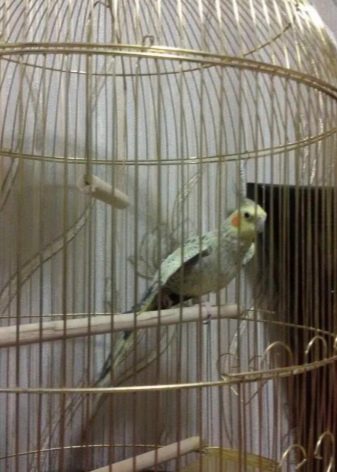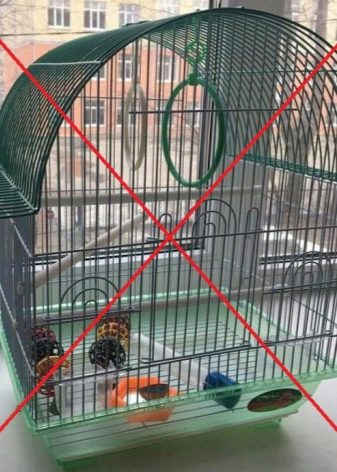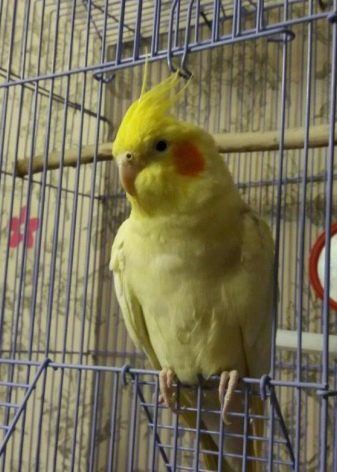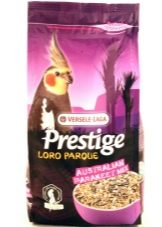Care and maintenance of a parrot cockatiel

Corella is a tame parrot that can talk. The bird is a relative of the cockatoo, it has an external resemblance to it. The cockatiel has a short beak, a large tail, which has a pointed appearance and reaches 16 centimeters in length.
Peculiarities
The parrot itself is medium in size, about 31 cm; weight about 91 grams. In most cases, it is a pet. There is a long crest on the head of the parrot, which can rise and fall (it depends on the mood of the bird). The plumage of the cockatiels is not striking. Colors such as gray, white and yellow are present. The bird has expressive features, thanks to which you can admire it for a long time.
The male cockatiel is more elegant and flamboyant than the female. It has a dark gray body, yellow crest and head, orange spots are present on the cheeks, the wings and tail are black-bluish in color. Males can actively and quickly develop, they chirp louder and more often can bang their beaks on the cage. The female is calm, has gray feathers; there are brown spots on the cheeks, the upper body is light yellow, and the lower body is dark.


Corella acquired the name of a nymph; their homeland is Australia. In Australia, they can be seen almost everywhere, because this is where the climate is good for this species of parrots. But parrots love to settle in the depths of the continent: where there are savannas, good shrubs, eucalyptus groves. Parrots usually live on dry, long trees, where their gray tone almost does not stand out against the background of the surrounding species.
These birds get used to and become attached to humans. Birds like to be around people.
There are few species of cockatiel parrots. All of them practically do not differ from each other.All of them can be tamed, provided with the necessary conditions of detention, and taught to speak. You can find mother-of-pearl, brown, variegated cockatiel parrots. Some have a combination of colors.


Cell selection
A capacious, spacious cage is necessary for a cockatiel. You need to purchase a large cage that has the minimum dimensions: length - 62 cm, width 42 - cm, height - 72 cm. It is important that the bird has a long cage. If the cage is not long, then the cockatiel can injure its wings or break its tail.
The base of the cage can be round, square or rectangular. If the corners are not present, then the corella will become nervous, because she will be uncomfortable. In cells, the rods are almost always horizontal. This allows the parrot to move perfectly along the walls, clinging to them with its claws and beak. But there are cells that have vertical bars. Therefore, when a product is purchased, it is necessary to choose cells with horizontal bars.


The cage must contain pull-out tray that can be cleaned without disturbing the parrot. But if the parrot starts flying around the house, then the cage can be completely cleaned. A pull-out tray is needed because it is easier to remove than the top of the cage.
The cage material must be environmentally friendly, durable, smooth so that the corella cannot be injured by sharp corners. Natural and sustainable wood is not suitable for poultry. Because the tree is difficult and inconvenient to clean, and pests can also start in it. Also, the tree cannot be treated with antiparasitic material, as this will cause poisoning in the parrot.
Plywood is a lightweight material, but it also has its drawbacks. An acceptable option is MDF board because it is highly environmentally friendly. Particleboard (particle board) contains formaldehyde resins, which are hazardous to the health of the parrot. The material must be strong enough that the parrot cannot break it.
The pallet should have long sides so that the food that the parrots eat does not spill out of the cage. Some models have additional grates, they are stacked on top of the pallet. The grate is necessary so that the parrot can only eat food; in addition, the feet of the birds will remain dry and clean.
Walls and roofs should be made of stainless steel rods or mesh. The distance between the rods should be not less than 22 millimeters.
This distance will prevent the parrot from sticking its head between the rods, and the bird will not be injured.



Location
It is necessary not only to choose a good and spacious cage, but also to correctly determine the area where the cage will be located. You cannot place a cage:
- in a room where a person rarely enters;
- in the kitchen where food is prepared and there is a lot of steam;
- in a room where there is too much noise;
- in places where there are electrical appliances;
- in places that are close to heating devices (dry air has a detrimental effect on feathers);
- in areas that are blown through (the bird will be able to tolerate cold air, but due to drafts it will hurt);
- on windowsills in too cold winter time and in hot summer time;
- near an open window, where there may be a draft or it will be too noisy, and this will scare the parrot.


The cage should be at the level of the person's face... If the parrot is a little lower, then he will feel depressed, and if he is a little higher, he will feel in charge. Corella is a sociable bird, she needs to observe the happening moments, she needs to hear human voices. There is no need to place the cage in the middle of the room - the Corella can only feel protected if the sides of her house are well pressed against the wall. Corella can be stressed: if she is frightened, she loses consciousness or sheds feathers.
Indoor light. You need to create the right contrast. Do not allow too hot and bright light, from which the bird cannot hide.
It is necessary that the temperature is at room temperature, and the light is not too bright.


Nutrition rules
There are a wide variety of healthy foods for cockatiels. You need to know what should be the diet of a bird in its natural environment. The main ones are seeds from the fruits of wild plants, as well as the pulp of the fruit. Parrots can eat grass and grains, insects and larvae.
Feeding cockatiels at home. The bird should eat a variety of quality foods. There are some rules you need to know to feed your poultry safely.
- You can give vegetables, citrus fruits, fruits.
- Do not feed the bird in large portions. The product must be safe for digestion.
- Before buying portions for a month, you need to try a small batch. You can experiment: if you soak seeds that can germinate, they will become useful for feeding.
- It is necessary to find out the needs of the cockatiel. If the bird lacks any substances, then the diet needs to be supplemented with the missing elements.


Feed
Before choosing food, you need to pay attention to proven products.
- Versele-laga is a Belgian brand. He presents 2 lines: Prestige Big Parakeets is a natural product that contains a huge composition of cereals. Prestige Australian Parakeet contains granules that contain vitamins.
- Italian brand Padovan. Food that contains fruit and biscuit crumbs.
- Products from RIO... There is food for the cockatiel during molting, and there is also a main diet.
- Vitakraft is a German brand. Represents 3 lines: NATURE DINNER - it contains raspberries; Australian - cactus leaves and eucalyptus are present; Vitakraft MENU is the main diet, it contains nuts and honey.




Complementary products.
- dandelion leaves, celery, corn;
- branches of birch, linden, spruce;
- apples, pears, pineapple, lemon, cherries;
- if there is not enough protein, then you can give lean meat in small portions, cottage cheese and boiled eggs.
For a cockatiel chick, dry mixtures are suitable, which are diluted in liquid so that they turn out thick. Next, the mixture should be allowed to cool to 40 degrees, and then feed the chick.


Feeding a sick bird
If the parrot does not have enough minerals, then this affects health. If there is not enough vitamin A, then skin diseases will appear. You can add the missing substances: river sand or mineral stone. The calorie content of the feed should not be allowed so that the bird does not become obese. The diet in this case should be light and contain cereal products.


Daily rate
- It is recommended to empty the cage of the remaining feed and pour in fresh feed in the evening. Then you need to cover the cage, and in the morning the bird will start its day.
- For one parrot, 16-26 grams of feed is enough.
- There are no restrictions on the amount of fruits and vegetables eaten. You need to cut vegetables and fruits into cubes or grate.
- To get enough calcium, you need to grate the shell of a boiled egg.


What should not be given to a parrot?
- it is forbidden for cockatiels to give pieces of avocado and mango, they must be included in dry food;
- Do not give herbs that contain essential oils, such as parsley;
- seasonings are prohibited;
- you cannot give bread, only biscuit crumbs;
- no human food should be given.


Hygiene
Cockatiels love to swim. Hygiene and prevention of dry skin must be observed.
Parrots love to swim in different ways, for example in baths or wet grass and leaves, some like to stand under running water. There are cockatiel parrots who like to stand under a trickle of liquid, and then leave when they are completely wet.
Corella can be bathed in a bath. In the summertime, you should keep the tub open for the parrot, because the cockatiel gets very hot, and she will climb in there several times a day so that the skin does not dry out. You don't have to buy a special bath in the store, you just need to use a simple container that has an average depth.The liquid must be poured under the growth of the parrot. The parrot should feel the bottom, there should be a lot of water so that the cockatiel can wash comfortably. In the summer, the liquid needs room temperature. The water needs to be changed once every 2 days.
You can bathe the cockatiel in the sink. The sink must be free of any traces of cleaning agents. If after washing the dishes there is a plaque left on the sink, then the parrot will be able to drink from this sink or swim there. It is necessary to thoroughly clean everything and leave a thin stream of water so that the parrot can stand and swim. You can try the spraying option. In winter, the parrot rarely takes a bath.
Do not dry the cockatiel with a hairdryer. Better to plant the bird in a warm bath over a heated towel rail. Wrap the heated towel rail itself with a towel so that the parrot does not have contact with hot metal.


Possible difficulties
Some difficulties may occur with the cockatiel parrot. So that the bird does not get sick, good housing conditions are needed. Corella is ill infrequently, if she is sick, then her appearance and behavior will change. A parrot that is sick cannot respond to stimuli, he sits with his eyes closed and does not eat anything. The reasons for the poor condition of the bird are: parasites, intestinal upset, goiter infections, inflammation of the eyes, persecution, colds.
If you do not manage to find out the diseases of the cockatiel yourself, the needs to be taken to the veterinarian, and then the bird should be provided with the necessary conditions so that he recovers as soon as possible. If the cockatiel lives at home, then it will live longer. A tame cockatiel can live up to 17-19 years if it is well looked after.
Here are some guidelines to help your parrot get comfortable with the new habitat:
- Items such as computer, radio, television must be removed from the room. They make a lot of sound. You can't shout, you need to talk quietly.
- You need to talk gently and calmly with a parrot in order to arouse friendliness in the feathered.
- It is necessary to change the usual way of life, the Corella must observe everyone.
- You can't move abruptly next to the cage and stick your fingers through.
- The parrot must be protected from guests until the bird can get used to the owner.
Adaptation of cockatiels depends on the nature of the parrot and can last about 14 days.


Owner reviews
- Corella has its own character. She may love children, but she can be vociferous.
- The bird is funny, friendly, clean. She is able to learn, loyal to the owner, but she needs a spacious cage.
- Corella is smart, funny, quick-witted, beautiful, smart, but screams too loudly.
- The parrot gives a positive attitude every day, can imitate different melodies. But its maintenance requires certain expenses. For some people, buying a bird itself is not cheap.
Some owners have taught the cockatiel to speak to humans. Some have managed to teach the bird hundreds of words and phrases. If the owner takes good care of the pet, then in some cases the bird lives up to 26 years.
The bird itself can wake up early and scream. It may even bite the owner.

Corella is a positive family friend and needs a lot of attention. The parrot can be arrogant, too curious. Lots of litter. If you take young cockatiels, then they can be easily and quickly taught. They can be very affectionate. For some, Corella is a sheer punishment. She is very beautiful, but she screams loudly and bites painfully. Thus, Corella is a wonderful parrot, it just needs care and attention.
For information on the features of caring for a parrot, see the next video.








